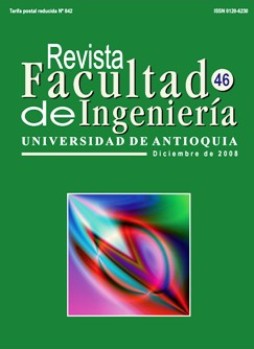Sensitivity analysis for the positioning of electrodes in surface electromiography (semg)
DOI:
https://doi.org/10.17533/udea.redin.17930Keywords:
Biomedical engineering, electromyography, quadriceps musclesAbstract
The surface electromyography is widely used in laboratories of movement analysis due to its easy manipulation and its noninvasive character. However, this extended use generates a variation in the protocols and produces difficult to compare results [1]. In the present study, an analysis of sensitivity for the positioning of bipolar electrodes is made on three muscles of the quadriceps: vastus lateralis (VL), vastus medialis (VM) and rectus femoris (RF). The three main factors of the study are: a. the longitudinal position of electrode, b. the orientation of electrode and c. the angle of extension of the knee. Additionally, the response factors are the maxima force and the RMS of the EMG signal. The tests were made for maxima voluntary contraction (MVC) during an isometric force. We conclude that there are differences in the EMG signal when the electrodes are in different position and orientation. The best distance for the electrodes is 22.59 ± 2.84% for the VL, 29.44 ± 1.88% for the VM and 66.28 ± 0.38% for the RF from the apex of the patella. The best orientation of the electrodes is 0° for the VL, 70° for the VM and -20° for the RF.
Downloads
References
H. J. Hermens, M. M. R. Vollenbroek-Hutten. “Effects of electrode dislocation on electromyographic activity and relative rest time: effectiveness of compensation by a normalisation procedure”. Medical & Biological Engineering & Computing. Vol. 42. 2004. pp. 502-508. DOI: https://doi.org/10.1007/BF02350991
S. H. Roy, C. J. De Luca, J. Schneider. “Effects of electrode location on myoelectric conduction velocity and median frequency estimates”. J. Appl. Physiol. Vol. 61. 1986. pp. 1510-1517. DOI: https://doi.org/10.1152/jappl.1986.61.4.1510
S. E. Mathiassen, G. Hägg. “Amplitude aspects and functional considerations on surface EMG electrode displacement with particular emphasis on the upper trapezius muscle”. H. J. Hermens, B. Freriks, (editors). SENIAM. 1997. pp. 84.
H. J. Hermens, B. Freriks, C. Disselhorst-Klug, G. Rau, “Development of recommendations for SEMG sensors and sensor placement procedures”. J. Electromyogr.Kinesiol. Vol. 10. 2000. pp. 361-74. DOI: https://doi.org/10.1016/S1050-6411(00)00027-4
C. J. De Luca, “The use of surface electromyography in biomechanics”. J. Appl. Biomech. Vol. 13. 1997. pp. 135-163. DOI: https://doi.org/10.1123/jab.13.2.135
A. Rainoldi, G. Melchiorri, I. Caruso. “A method for positioning electrodes during surface EMG recordings in lower limb muscles”. J. Neurosci. Methods. Vol. 134. 2004. pp. 37-43. DOI: https://doi.org/10.1016/j.jneumeth.2003.10.014
K. Saitou, T. Masuda, D. Michikami, R. Kojima, M. Okada. “Innervation zones of the upper and lower limb muscles estimated by using multichanel surface EMG”. J. Human Ergol. Vol 29. 2000. pp. 35-52.
K. Ebersole, T. Housh, G. Johnson, T. Evetovich, D. Smith, S. Perry. “MMG and EMG responses of the superficial quadriceps femoris muscles”. Journal of Electromyography and Kinesiology. Vol. 9. 2004. pp. 219-227. DOI: https://doi.org/10.1016/S1050-6411(98)00036-4
F. C. T. Van Der Helm, G. Yamaguchi. “Morphological data for the development of musculoskeletal models: An update”. J. M. Crago P (Editor), Neural control of posture and movement, Winters Springer Verlag, New York, 2000. pp. 645-658.
Morphological data. http://mms.tudelft.nl/morph_data/main.htm, Consultada mayo 10 de 2006.
Parameters for a model of the lower limb.http://isbweb.org/data/delp/index.html. Consultada mayo 10 de 2006.
G. M. C. De Vito, D. Hugh, A. Macaluso, P. E. Riches. “Is the coactication of biceps femoris during isometric knee extension affected by a asiposity in health young humans?”. J. Electromyogr Kinesiol. Vol 5. 2003. pp. 425-31. DOI: https://doi.org/10.1016/S1050-6411(03)00061-0
M. O. Ericson, R. Nisell, U. O. Arborelius. “Muscular activitiy during ergometer cycling”. Scand. J. Rehabil Med. Vol 17. 1985. pp. 53-61.
G. L. Soderberg, D. Vanderlinden, C. Zimmerman. Electrode site location for maximizing EMG output for selected muscles. Unpublished data, The University of Iowa, 1988.
T. Fukunaga, Y Ichinose, M Ito, Y. Kawakami, S. Fukashiro. “Determination of fascicle length and pennation in a contracting human muscle in vivo” J. Appl. Physiol. Vol 82. 1997. pp. 354-358. DOI: https://doi.org/10.1152/jappl.1997.82.1.354
Downloads
Published
How to Cite
Issue
Section
License
Revista Facultad de Ingeniería, Universidad de Antioquia is licensed under the Creative Commons Attribution BY-NC-SA 4.0 license. https://creativecommons.org/licenses/by-nc-sa/4.0/deed.en
You are free to:
Share — copy and redistribute the material in any medium or format
Adapt — remix, transform, and build upon the material
Under the following terms:
Attribution — You must give appropriate credit, provide a link to the license, and indicate if changes were made. You may do so in any reasonable manner, but not in any way that suggests the licensor endorses you or your use.
NonCommercial — You may not use the material for commercial purposes.
ShareAlike — If you remix, transform, or build upon the material, you must distribute your contributions under the same license as the original.
The material published in the journal can be distributed, copied and exhibited by third parties if the respective credits are given to the journal. No commercial benefit can be obtained and derivative works must be under the same license terms as the original work.










 Twitter
Twitter